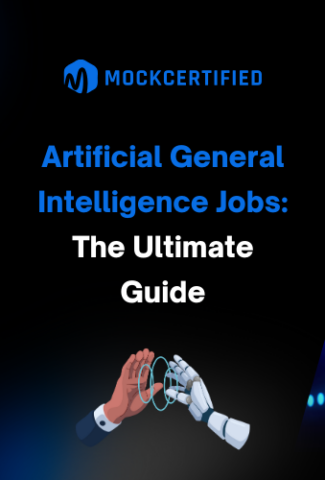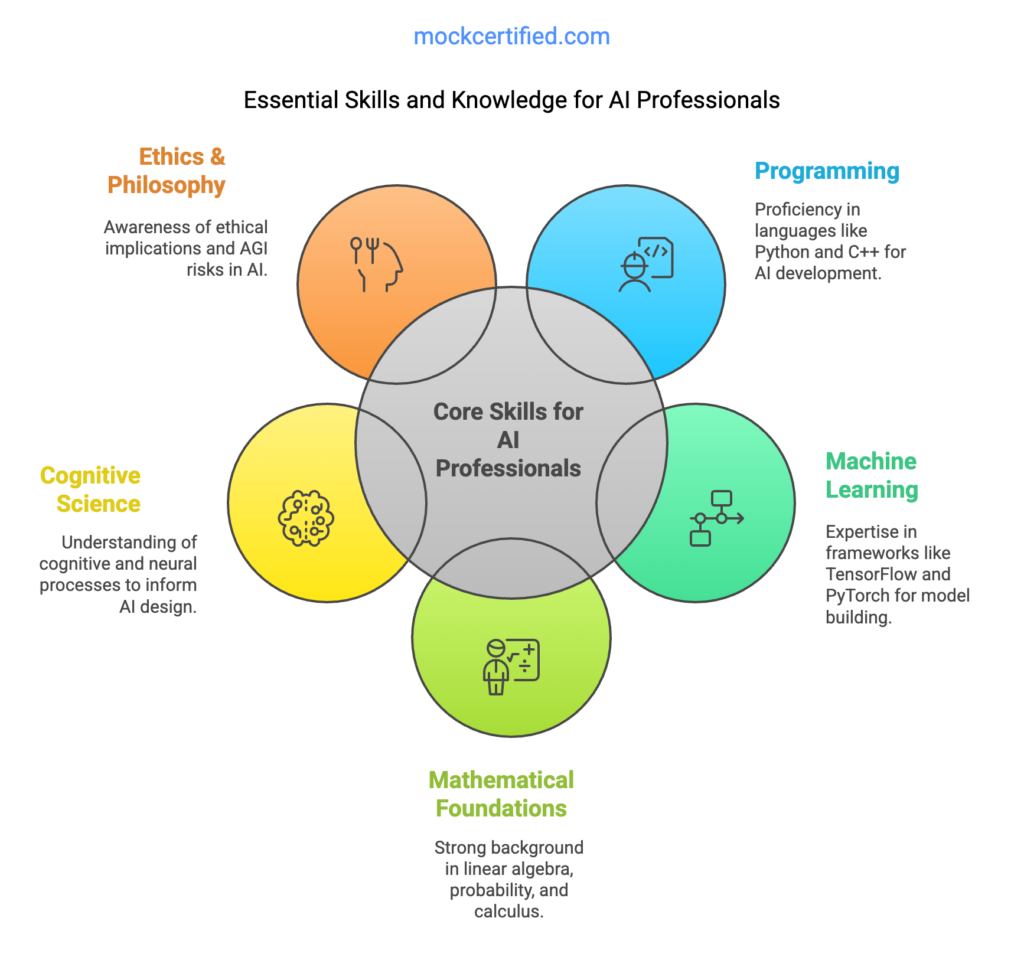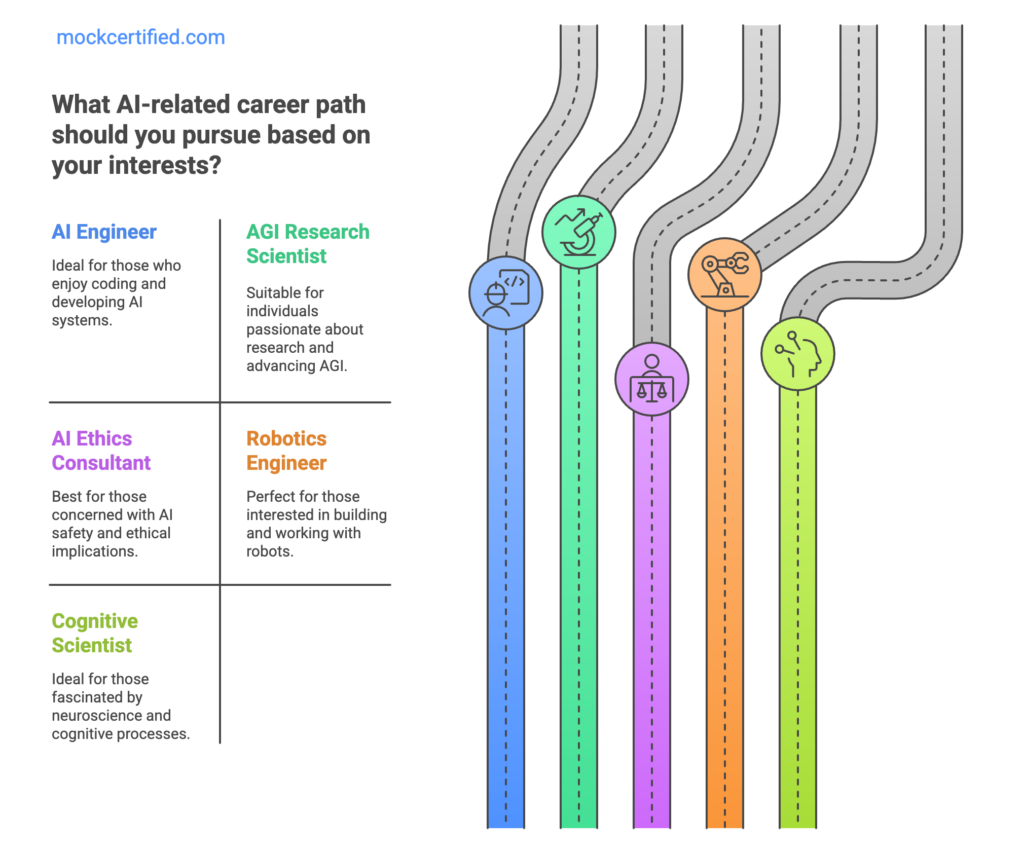
Among the most interesting yet difficult fields in technology is artificial general intelligence (AGI).
AGI seeks to think and learn like a person, whereas many people confuse it with normal artificial intelligence, which is meant for particular tasks (like image recognition or chatbots).
Artificial general intelligence jobs are thus highly technological, modern, and—quite futuristic, cutting edge. Still, if this career route appeals to you, be assured—that is the focus of this blog.
1. What is Artificial General Intelligence (AGI)?
AGI refers to AI systems that can perform any intellectual task a human can do.Unlike narrow artificial intelligence (such as Siri or ChatGPT), AGI would have reasoning, problem-solving capacity, and adaptability across many tasks without being especially educated for each one.
Although AGI is not yet fully developed, researchers and tech companies are actively developing it; hence, some of the most advanced and competitive AI jobs are those related to AGI.
2. Are Artificial General Intelligence Jobs Different from Regular AI Jobs?
Many AI jobs today focus on narrow AI, where models are trained for specific tasks—think recommendation algorithms, fraud detection, or self-driving cars.
On the other hand, AGI jobs include:
- Building AI that learns on its own without requiring fresh data for every job.
- Research on artificial intelligence alignment and safety guarantees that AGI won’t turn into a threat to human existence.
- Understanding human cognition helps us create AI that replicates actual intelligence.
In basic terms, AGI jobs requires a better knowledge of artificial intelligence, human intellect, and problem-solving than standard AI occupations.
But you could wonder: narrow artificial intelligence like ChatGPT can now reason, possess problem-solving abilities, and adapt as well…Hence, what divides them?
| Feature | Narrow AI (Regular AI Jobs) | AGI (Artificial General Intelligence Jobs) |
| Scope | Designed for specific tasks (e.g., image recognition, chatbots) | Can think, learn, and adapt across any task like a human |
| Learning Ability | Learns from large datasets, but struggles with new tasks without retraining | Learns like humans, understands new problemswithout needing extra data |
| Reasoning & Problem-Solving | Can solve problems within a fixed domain (e.g., fraud detection) | Can apply logic & reasoning to any new situation |
| Examples | ChatGPT, Tesla’s self-driving AI, recommendation algorithms | (Future) AI that thinks, plans, and creates like a human |
| Job Focus | Machine Learning Engineer, Data Scientist, AI Software Developer | AGI Researcher, AI Alignment Specialist, AI Ethics Consultant |
| Current State | Already widely used | Still in research stage, but companies are hiring for it |
3. What Are Artificial General Intelligence Jobs?
Although artificial general intelligence is still developing, here are some important job paths for those who wish to be part of this future, along with what these experts really do and how they equip AGI models.
AI Researcher (AGI-oriented)
What they do:
- Researches fresh methods and architectures that enable artificial intelligence to reason and think like humans.
- Designs self-learning models capable of extending knowledge across several tasks.
- Works on meta-learning—that is, artificial intelligence learning.
How they teach AGI models:
- Makes use of vast datasets spanning several domains—language, robotics, vision, etc.).
- Runs reinforcement learning experiments, just like DeepMind taught AlphaGo.
- Develops multi-modal models that can process text, images, and actions together.
📌 Example: An AI Researcher at OpenAI might develop a model that learns physics principles by playing with a virtual world—without being explicitly programmed
Cognitive Scientist
Their work:
- Focuses on human intelligence—memory, learning, reasoning—as it exists.
- Facilitates the creation of human-like artificial general intelligence models.
- Work collaboratively with neuroscientists and psychologists to integrate brain-inspired computing
The training of their AGI models
- Uses brain-scanning data (FMRI, EEG) to replicate cell processing of information.
- Studies human learning curves to raise the effectiveness of AI training.
- Tests neuromorphic computing—hardware which mimics the brain.
For instance, a DeepMind cognitive scientist might assist in creating an artificial general intelligence (AGI) that learns new skills as quickly as a kid instead of requiring thousands of training examples.
AGI Software Engineer
What they do:
- Builds the actual AGI systems and programs them to learn like humans.
- Develops frameworks for self-learning and autonomous decision-making.
- Optimizes AGI models for scalability and real-world applications.
How they train AGI models
- Uses unsupervised learning, allowing AI to discover patterns on its own.
- Implements transfer learning so AGI can apply knowledge from one task to another.
- Works with massive computational power (GPUs, TPUs, quantum computing).
Example: An AGI Software Engineer might develop an AI assistant that learns new programming languages just by reading documentation and coding examples—without being explicitly trained for each language.
AI Ethics Consultant
What they do:
- Ensures AGI is developed safely and ethically.
- Creates rules and policies to prevent AI from causing harm.
- Works on AI bias, fairness, and decision transparency.
How they train AGI models:
- Designs ethical guidelines for AI decision-making.
- Tests AGI systems to identify potential biases.
- Works on explainability models so humans can understand AI decisions.
Example: An AI Ethics Consultant might evaluate a self-learning AGI medical system to ensure it doesn’t develop biases against certain patient groups.
Robotics Engineer
What they do:
- Integrates AGI into physical robots.
- Develops AI-driven robots that learn from experience rather than being pre-programmed.
- Works on human-AI interaction for robotics.
How they train AGI models:
- Uses real-world reinforcement learning (e.g., robots learn by trial and error).
- Implements sim-to-real training—AI is trained in a simulated environment before being deployed in real life.
- Builds robots that learn from humans through demonstration (imitation learning).
Example: A Robotics Engineer might develop a robot chef that learns to cook new dishes by watching YouTube videos—without being explicitly coded for each recipe.
AI Alignment Researcher
What they do:
- Ensures AGI aligns with human goals and values.
- Works on safety mechanisms to prevent AGI from going rogue.
- Studies how to control AGI’s decision-making processes.
How they train AGI models:
- Develop reward modeling so AGI makes ethical decisions.
- Tests constraint-based learning (AGI must stay within human-defined boundaries).
- Uses human-in-the-loop training, where humans constantly guide AI’s learning.
Example: An AI Alignment Researcher might work on making AGI refuse unethical commands, like hacking or deception, even if they aren’t explicitly forbidden.
4. What Skills and Certifications Do You Need?
Since Artificial general intelligence jobs is cutting-edge, you need some serious skills. But don’t worry—you can learn them step by step.
Core Skills:
- Programming: Python, C++, and sometimes Lisp or Julia
- Machine Learning & Deep Learning: TensorFlow, PyTorch
- Cognitive Science & Neuroscience (optional but useful)
- Linear Algebra, Probability, Calculus
- Ethics & Philosophy of AI (to understand AGI risks)

Best Certifications & Courses
🎓 MIT’s AI Courses – Covers deep learning and AGI fundamentals.
🎓 DeepMind’s AGI Research Papers – Great for self-learning.
🎓 Fast.ai’s Deep Learning Course – A practical way to start.
🎓 OpenAI & Google AI Research – They offer great resources on AGI.
You don’t necessarily need a PhD, but strong knowledge in these areas is essential.
5. What Background is Needed to Get Into AGI Jobs?
Artificial General Intelligence teaches machines to think like humans, not only codes. Professionals in this field thus come from many backgrounds, including computer science and engineering (machine learning, neural networks, artificial intelligence development).
- Probability, logic, optimization—mathematics and statistics
- Neuroscience & Cognitive Science (being familiar with human learning and reasoning)
- Philosophy and Ethics (AI safety, consciousness, decision-making)
To get Artificial General Intelligence jobs, nevertheless, you do not need a Ph.D. Many self-taught programmers break through by honing the appropriate skills. Where you are right now determines the road.
If You’re a Beginner (Starting from Scratch)
1️⃣ Learn Python & AI Fundamentals
- Start with Python since it’s the most-used language in AI.
- Learn machine learning basics (supervised & unsupervised learning).
Courses to take:
2️⃣ Dive into Deep Learning
- Study Neural Networks, TensorFlow, PyTorch.
- Focus on transformers (GPT, BERT) since they power modern AI.
Take a look at these courses:
- “Deep Learning Specialization” (Coursera by Andrew Ng)
- “FastAI Deep Learning Course” (Fast.ai)
3️⃣ Start Working on AI Projects
- Build small AI models (e.g., handwriting recognition, chatbots).
- Contribute to open-source AI projects on GitHub.
- Follow AGI research from OpenAI, DeepMind, and Anthropic.
4️⃣ Join AGI Research Communities
- Participate in forums like LessWrong, Alignment Forum, AI Safety Discord.
- Attend AI workshops, hackathons, and conferences.
- Read papers from arXiv, DeepMind, and OpenAI blogs.
If You’re Already in AI (But Want to Shift to AGI)
1️⃣ Focus on Meta-Learning (AI That Learns to Learn)
- Traditional AI learns from big datasets, but AGI should generalize.
- Study meta-learning (AI that adapts to new problems with little data).
Suggested reading:
- “Model-Agnostic Meta-Learning (MAML)” by Chelsea Finn
- DeepMind’s research on self-supervised learning
2️⃣ Dive into AI Alignment & Safety
- AGI must align with human goals—or it could act unpredictably.
- Study value learning, reward modeling, and reinforcement learning safety.
Suggested resources:
- “The Alignment Problem” by Brian Christian
- AGI safety research from Alignment Forum & AI Impacts
3️⃣ Get Hands-On with AGI Research
- Work on few-shot learning (models that learn from very little data).
- Explore cognitive architectures like ACT-R and SOAR.
- Apply to AGI research programs at OpenAI, DeepMind, or Anthropic.
Struggling with a Complex Topic? 🤔
Learning something new can feel overwhelming, especially related to AGI. That’s where MockBuddy comes in! Just type in the topic you’re trying to work on, and MockBuddy will generate in-depth MCQs to test your knowledge and reinforce key concepts.
No more passive reading—learn by doing and make tough topics easier to understand!
6. Beginner-Level vs. Senior-Level AGI Jobs
- Beginner roles: AI Research Assistant, AI Software Developer, Data Analyst for AI
- Mid-level roles: Machine Learning Engineer, AI Research Scientist
- Senior roles: Chief AI Officer, AGI Research Lead, AI Ethics Director
Most AGI roles require research experience, so start with machine learning jobs and work your way up!
7. Artificial General Intelligence Jobs: Which is Best for You?
- If you enjoy coding → AI Engineer
- If you enjoy research → AGI Research Scientist
- If you care about AI safety → AI Ethics Consultant
- If you enjoy robotics → Robotics Engineer
- If you’re into neuroscience → Cognitive Scientist

Since AGI jobs are wide, choose one that best suits your qualifications!
8. Is It a Long Process, and Is It Worth It?
✔️ AGI is a long-term career path; learning AI and deep learning can take years.
✔️ But depending on experience, AGI jobs generally pay $120K-$500K+ annually, which is quite fulfilling.
✔️ Once AGI is closer to reality, the job market for it will explode, hence getting started early is an excellent plan.
This is well worth it if you enjoy seeing the future of artificial intelligence developed!
9. Where to Find Artificial General Intelligence Jobs?
If you’re serious about working in AGI, check out these companies:
🏢 OpenAI – Leading AGI research.
🏢 DeepMind (Google) – Working on AGI and deep learning.
🏢 Anthropic – Focused on AI alignment.
🏢 Meta AI & Google AI – Large-scale AI projects.
🏢 AI Startups – Many small companies are exploring AGI.
Best Job Boards & Communities:
📌 AI Alignment Forum – For research-focused AGI jobs.
📌 ML & AI Twitter (X) Communities – Many AGI experts post jobs here.
📌 OpenAI & DeepMind Career Pages – They post AGI roles regularly.
Ditch the 9-to-5
If you don’t want typical 9-to-5 artificial general intelligence jobs and dream of leading the next wave of AI innovation, this is your chance. Gumloop, an AI automation startup, is on a mission to reshape how businesses use AI—and they’re looking for founding members to join them.
What is Gumloop?
Gumloop is an AI-powered automation platform that lets businesses streamline workflows without coding or AI expertise. Think of it as a drag-and-drop tool for automating complex tasks, from managing customer support to processing documents—no developers needed.
Big Moves: $24.5M Funding
Gumloop recently raised $24.5 million in Series A funding and is relocating to Silicon Valley, the heart of AI innovation. This funding will fuel their growth, expand their AI capabilities, and bring in top talent to push the boundaries of automation.
Why This Matters for AGI & AI Jobs
With AI transforming industries, Artificial general intelligence jobs are on the rise. Gumloop isn’t just another startup—it’s a place where you can shape the future of AI automation, take on leadership roles, and work on groundbreaking projects. If you want to be at the forefront of AI without the constraints of a corporate desk job, this is your shot.
Final Thoughts
The most complex AI jobs are Artificial general intelligence jobs, which call for extensive technical knowledge and research experience. Anyone can still enter this field with the correct learning route.
🚀 How to launch your AGI career?
1️⃣ Understand Python and machine learning foundations.
2️⃣ Courses in deep learning and artificial intelligence.
3️⃣ Join AGI research communities.
4️⃣ Get experience in AI professions such engineer, scientist, etc.,
5️⃣ Work on open-source AI projects on GitHub.
Though the road is difficult, the benefits—high pay, innovative research, and future development of artificial intelligence—make this one of the most interesting professional routes available today!



